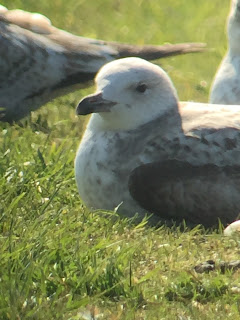My
request from my fellow patchers as to where to go today was, refreshingly, met
with polite suggestions, chief among them was Jamie’s idea to check the
Lockwood for new migrants. (obviously now he has repented and renounced Gulling
I took this idea at face value, not suspecting for a moment that he could have
more sinister motives)
It
was cold, bitingly so, in a stiff Nor’eastely. However the Sun was burning
through, so with an optimistic air I sallied forth up the East bank of the
Lockwood. I’m not sure where the optimism died but it was long before I got hallway
up.
The
reservoir was pretty devoid of anything resembling a migrant, the only thing
that looked to be worth looking at were (surprise, surprise) Gulls. About 100
LWHG’s on the West bank called out to be scrutinised, why they all decided to
take flight and disperse remains a mystery as, contrary to last Friday, when
the banks were thronged with walkers, truants and dudes today I had the place
to myself.
Around
the top of the High Maynard a single ‘wiisp’ call failed to resolve itself into
any sightings and despite hoping that it was a Rock Pipit and would turn up at
the North end later it was not to be.
Expecting
it to be on the water’s edge I had dropped down to the concrete edge and
wandered North, I got nearly to the North-east corner when I spotted the head
and shoulders of a Gull facing away from me on the grassy bank. It felt good,
it felt Caspian good. Mindful that Lol ‘needed’ (how he hates that wordJ) it for the patch I stopped and called
him.
“Turn
your head ever so slightly and look out of your window” I said “ I’m pretty
sure I’ve got a Caspian Gull standing on the bank, I won’t approach any closer
until you’ve seen it”
“O.K”.
he said “I’ll just get showered, dressed and have breakfast then I’ll have a
look”
“!!!!!” “It’s right outside of your house, have a
look!”
“Alright,
I’ll call you back”
I
looked back and the bird had gone…nothing was in the air so I guessed it had
just dropped off the bank…Lol called back.
“I
can’t see it”
“No
neither can I, I’ll try walking up further and call you back”
I
walked up and saw it on the North side of the concrete edge, long story (yes, I
know it’s already been a long story) short I recalled Lol and he said he was on
his way.
It
was quite confiding and was sat down most of the time and when it did stand
appeared to only have one leg, though after rattling off stacks of shots I
realised it actually had two. Something was definitely wrong with its left leg
though as it consistently held it out of view and was always the first Gull to
sit down and last to get up.
For
some unknown reason all the Gulls relocated to the West bank, Lol eventually
appeared, we strolled down there and re-found it. Being a new bird for him he
was nervous of accepting my word on its identification. (The cheek of it! Though
I had earlier tried to point out an adult Yellow-legged Gull to him that on
second looks was actually a summer-plumaged Common Gull so possibly
understandable) After a few congratulatory tweets from other Gull-aholics he
seemed to be happier and I would imagine there is now an inky tick in the
previously empty box next to Caspian Gull on his list, if he keeps one. Feel
free to find me an AvocetJ
I
thought I would check the West Warwick but apart from getting the run-around
from a washed out grey and white small Grebe I had Little to show for my
efforts (pun not intended but I’ll leave it in).
After
news that the Essex FB Firecrest had been seen again today I thought I would
give it a try. You have to look across the Lea, to the Essex side, from the
Middlesex FB, but I’m not proud. I wish I had have been, as once I did get to
see the bird I was left with an uneasy feeling that it could be a hybrid Rather
like the one Here:
I’m not saying there is not a Firecest there but the, admittedly poor, views I
had means I won’t be counting what I saw of it.
As
for migrants, I know what you did there Jamie. Stop making me look at Gulls.
@birdingprof





























































